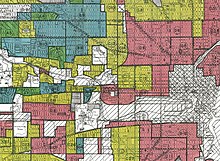Child poverty in the United States
[5] Parents who have an education only up to a high school diploma or less are much more likely to be poor due to the lack of high-paying jobs for low-skilled workers.
[5] This population may have a lower quality education as well if they grew up in a poor community, and this also causes them to be less skilled and desirable to employers.
Many key industries have disappeared from these areas, resulting in service sector jobs that have lower pay and are less stable replacing them.
[8][5] The South is especially unique[editorializing] because it has a history of racial discrimination, agriculture dependency, and, more recently, manufacturing opportunities.
[11] On the eve of the Covid-19 pandemic, in 2019, the child poverty rate in the United States was nearly double that of several peer countries, including Canada, South Korea, and Germany.
[11][14] Though some schools implemented grab-and-go meals, only 11% of families utilized this because many children who need it have parents who cannot take time off of work or do not have transportation.
[14] This leads to children lagging behind their more wealthy counterparts and associated with higher drop-out rates and lower educational outcomes.
There is a history of racism in the United States with the institution of the slave trade, Jim Crow laws, and the war on crime that incarcerated black men disproportionately.
[15][16] The effects of racism continue to be prevalent in the disparities found in the country and affect minority communities in many different institutions.
[15] Racial profiling played a role in excessive arrests and incarcerations due to drug offenses that majorly impacted black and Latinx communities.
[15] However, for minority communities, especially black families, house ownership is not a realistic possibility due to the high rates and historic discrimination.
[15] This caused many black communities to have fewer opportunities to move to better housing because the prices would be hiked up to discourage them and lenders would not give money at reasonable rates.
Obesity is also a common effect of children in poverty, most probably due to less access to nutritional foods, and this can have complications in the future.
[citation needed] Children in poverty also often have trauma, which can cause greater mental health problems like ADHD and mood and anxiety disorders.
[8] Mental health disorders in patients in child poverty are actually more prevalent and can affect their life on an everyday spectrum because it may restrict how they interact with others and their opportunities to learn.
[9] A study shows that children below the poverty line do two years less of an education which causes a ripple effect of fewer opportunities and less income.
[20] At that time, welfare policies began to take place and the role of the federal government in poverty reduction increased.
[15] To cover basic needs, the government has provided assistance programs and tax credits that lower the burden on families.
[20] Later replaced by the Temporary Assistance for Needy Families (TANF), the program is based on income levels and assets.
[21] Both SNAP and tax credits have helped reduce child poverty, improve educational outcomes, and raise employment levels.
[22] In terms of educational policies, Head Start is a federal program that targets early childhood learning and development and stronger parent-child relationships.
[8] For example, they can use connections to their advantage by having conversations, receiving advice, providing transportation, and getting information about government programs.
The program connects families in a school, and it is proven to increase skills in social, academic, and emotional behavior.
[8] Making Connections (MC) and Children's Services Council (CSC) are also a program that targets families to decrease child poverty.
[9] The progress that had been made during the Great Recession for educational investment and income support has been cut back due to fiscal restraint.
[16] Critics oppose this due to the idea that transfers disincentivize working, but examples of similar programs in Britain and Canada have shown to be successful.
[16] Along with cash transfers, other aims should include childcare support, vocational education, the creation of jobs, increased housing subsidies, etc.
[16] Restructuring the current system in the United States may also be a worthwhile effort, and this can be accomplished by keeping the major elements but changing specifics like target population, quantity of assistance, and delivery process.
[20] Medical-financial partnerships (MFP) have recently gained traction and have the potential to impact the health of poor children.
[24] Financial stress affects a large portion of the population with over half of families being income or asset poor.



